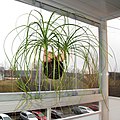Beaucarnea recurvata
| Beaucarnea recurvata | |
|---|---|

| |
| Scientific classification | |
| Kingdom: | Plantae |
| Clade: | Tracheophytes |
| Clade: | Angiosperms |
| Clade: | Monocots |
| Order: | Asparagales |
| Family: | Asparagaceae |
| Subfamily: | Nolinoideae |
| Genus: | Beaucarnea |
| Species: | B. recurvata
|
| Binomial name | |
| Beaucarnea recurvata | |
| Synonyms[3] | |
| |
Beaucarnea recurvata, the elephant's foot[4] or ponytail palm,[5] is a species of flowering plant in the family Asparagaceae. The species was native to numerous states of eastern Mexico but is now confined to the state of Veracruz.[1][6] Despite its common name, it is not closely related to the true palms (Arecaceae). It has become popular in Europe and worldwide as an ornamental plant. There are 350-year-old Beaucarneas registered in Mexico.[7]
Description
[edit]
It is an evergreen perennial growing to 15 feet 6 inches (4.72 m) with a noticeable expanded caudex, for storing water. The single palm-like stem produces terminal tufts of strap-shaped, recurved leathery leaves, sometimes hair lock-shaped in the ends, and with occasional panicles of small white flowers once the plant reaches over 10 years of age.
The only moderately swollen trunk at the base is slender over it and only slightly branched. The almost spherical caudex in the youth stage later becomes 4 to 6 meters long[citation needed] and reaches a diameter of up to 50 centimeters and more at the base. The bark is smooth. The green lineal, slightly rejuvenated and bent leaves are thin, flat or slightly ridged. They are 90 to 180 inches long and 15 to 20 millimeters wide.
Habitat
[edit]Its habitat is low deciduous forest, with average temperatures of 20 °C and an annual rainfall of 800 mm, and a well-marked dry season of between 7 and 8 months. These types of forests are in an altitudinal range of 0 to 1700 meters above sea level. They grow on rocky soils deficient in nutrients, cliffs and steep mountains. The plant is resistant up to 10 °C, and grows in full sun or partial shade. The plants are very slow growing and very tolerant to drought, in a pot or planted as an ornamental garden tree.[8]
Cultivation
[edit]Having gained the Royal Horticultural Society's Award of Garden Merit.[4] B. recurvata is often grown as a houseplant or an outdoor plant in temperate climate gardens. Slow-growing and drought-tolerant, Beaucarnea recurvata is hardy to 10 °C (50 °F), grows in full sun to light shade, and requires proper soil mix to drain when watered. However, be cautious not to over-water, as this will foster pests like the mealybug and cochineal insect. If going to be kept in places with strong winters, it must be an indoor plant as it cannot resist cold temperatures. To maintain its original shape, the ends of its leaves should not be snipped, and when repotted it must keep all of its roots.[9]
Conservation
[edit]The species of the genus Beaucarnea are mostly in critical condition due to various anthropogenic activities, which has led to severe fragmentation and destruction of their habitat. Additionally, the collection of seeds, seedlings, juveniles and adults for commercial use has affected population size and the proportion of sexes, thereby reducing fertilization possibilities and, consequently, seed production.[10] This exploitation process exposes this species, in a state of threat or extinction, by reducing the minimum viable size of the populations, as well as the deterioration of their genetic diversity.[9] Beaucarnea recurvata, is considered to be threatened according to Official Mexican Standard 059-ECOL-2010 of SEMARNAT in Mexico.
The species is listed in Appendix II of the Convention on International Trade in Endangered Species (CITES) meaning international trade in the species and its parts/derivatives is regulated by the CITES permitting system.[2]
Toxicity
[edit]The species is not toxic to dogs, cats or horses.[11]
Gallery
[edit]-
In Mounts Botanical Garden, Florida
-
Madeira garden
-
Parrot Jungle, Miami
-
Regrowth after a crown breakage, in Homestead, Florida
-
Ponytail Palm kept as an indoor potted houseplant.
-
Macro image of the serrated margin of a leaf from a 7-year-old potted plant.
References
[edit]- ^ a b Martínez Salas, E.; Samain, M.-S.; Fuentes, A.C.D. (2020). "Beaucarnea recurvata". IUCN Red List of Threatened Species. 2020: e.T136808293A137376209. doi:10.2305/IUCN.UK.2020-1.RLTS.T136808293A137376209.en. Retrieved 19 November 2021.
- ^ a b "Appendices | CITES". cites.org. Retrieved 2022-01-14.
- ^ "The Plant List: A Working List of All Plant Species". Retrieved May 16, 2014.
- ^ a b "RHS Plant Selector - Beaucarnea recurvata". Retrieved 15 April 2020.
- ^ "Beaucarnea recurvata". The Encyclopedia of Life.
- ^ Irish, Gary (2000). Agaves, Yuccas, and Related Plants: A Gardener's Guide. Timber Press. p. 187. ISBN 978-0-88192-442-8.
- ^ Instituto de Ecología A.C. video files, Mexico
- ^ Miranda, Faustino; Hernández-X, Efraim (1963). "The types of vegetation of Mexico and their classification". Boletín de la Sociedad Botánica de México. 28: 29–72. doi:10.17129/botsci.1084.
- ^ a b Nason, John D.; Hamrick, J. L. (1997). "Reproductive and Genetic Consequences of Forest Fragmentation: Two Case Studies of Neotropical Canopy Trees". Journal of Heredity. 88 (4): 264–276. doi:10.1093/oxfordjournals.jhered.a023104 – via ResearchGate.
- ^ Hernández SL, M. Martínez, G. Malda B., HA Castillo G., O. Salcedo G., Osorio R. Ma. L., A. Contreras H., R. Orellana L., C. Swords M., LE Carrillo S., KKE Almanza R., M. Capdevielle V, Ml Á. Herrera A. and M. Á. Pérez F. 2010. Final project report (ORN_PTA 09). Collection of elephant foot accessions ( Beaucarnea spp .) For germplasm conservation in Mexico . Autonomous University of Queretaro. 54 p.
- ^ "Bottle Palm". ASPCA. Retrieved 5 August 2023.










